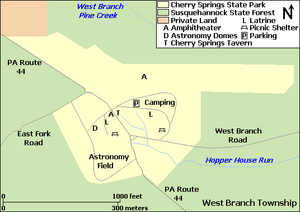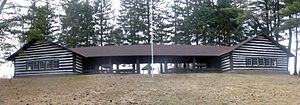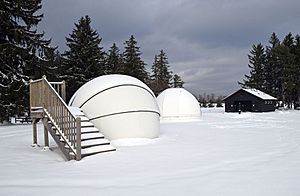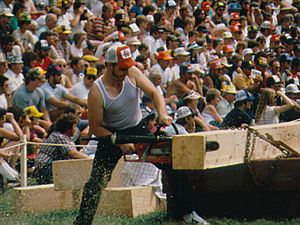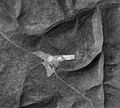Cherry Springs State Park facts for kids
Quick facts for kids Cherry Springs State Park |
|
|---|---|
|
IUCN Category III (Natural Monument)
|
|
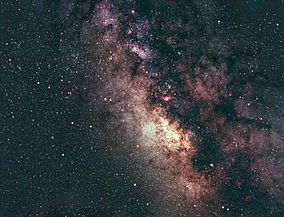
The sky at Cherry Springs State Park, the second International Dark Sky Park and the first in the eastern US, is so dark that the Milky Way casts a visible shadow.
|
|
| Location | West Branch, Potter, Pennsylvania, United States |
| Area | 82 acres (33 ha) |
| Elevation | 2,300 ft (700 m) |
| Established | 1922 |
| Named for | A large stand of cherry trees in the park |
| Visitors | 52,229 |
| Governing body | Pennsylvania Department of Conservation and Natural Resources |
| Website | Cherry Springs State Park |
Cherry Springs State Park is a special place in Potter County, Pennsylvania. It's an 82-acre (33 ha) state park known for its incredibly dark night skies. People from all over come here to see the stars! The park is located within the Susquehannock State Forest and sits high up on the Allegheny Plateau at 2,300 feet (701 m) elevation. It's named after a big group of Black Cherry trees that once grew here.
Cherry Springs is famous for having "some of the darkest night skies on the east coast" of the United States. In fact, the International Dark-Sky Association named it the second "International Dark Sky Park" in the world in 2007. This means the sky is so clear and dark that you can even see the Milky Way galaxy casting a shadow! The park is also known for its annual "Woodsmen's Show" and offers camping, picnicking, and trails for biking, hiking, and snowmobiling.
Contents
History of Cherry Springs Park
Early People and the Land
Long ago, about 12,000 years ago, early humans lived in what is now Pennsylvania. They were nomadic hunters who used stone tools. Later, people began to settle in villages and grow crops.
The first known people in the Cherry Springs area were the Susquehannocks. They lived in large long houses and built stockades around their villages. Sadly, diseases and wars with other tribes caused their population to shrink. By 1675, they had mostly left the area or joined other tribes. The nearby Susquehannock State Forest is named after them.
After the Susquehannocks, the Seneca nation, part of the powerful Iroquois group, hunted in this area. They had temporary hunting camps nearby. The Seneca allowed very few non-native people to pass through their lands. After the American Revolutionary War (1775–1783), most Native Americans left Pennsylvania.
Pioneers and Lumberjacks
In the early 1800s, European-American settlers began to arrive in Potter County. In 1818, a man named Jonathan Edgcomb built a tavern (like a small hotel) at the park's location. It was a very remote spot, about 16 miles (26 km) south of Coudersport. This place became known as "Edgcomb's Clearing."
A new, bigger hotel was built in 1874. It attracted wealthy visitors who came to hunt and fish. But this "sportsmen's paradise" didn't last long. The lumber industry arrived in the late 1880s. Lumberjacks cut down almost all the trees, especially the tall eastern white pine and eastern hemlock. This was called clearcutting.
After the trees were cut, the land was left bare and dry. This caused big fires, and much of central Pennsylvania became known as the "Pennsylvania Desert." The Cherry Springs Hotel itself burned down in 1897, and the area was left empty.
Building with the CCC
|
Cherry Springs Picnic Pavilion
|
|
| Location | 8 mi. N of Carter Camp off PA 44, West Branch Township, Pennsylvania |
|---|---|
| Area | less than one acre |
| Built | 1933 |
| Architect | Civilian Conservation Corps |
| MPS | Emergency Conservation Work (ECW) Architecture in Pennsylvania State Parks: 1933–1942, TR |
| NRHP reference No. | 87000052 |
| Added to NRHP | May 11, 1987 |
To fix the damaged land, Pennsylvania started buying "forest reservations" in 1897. The Susquehannock State Forest began in 1901. Today, this forest surrounds Cherry Springs State Park.
The park itself started in 1922 as the "Cherry Springs Scenic Drive." It also had one of the first public campgrounds. Much of what you see in the park today was built by the Civilian Conservation Corps (CCC). This was a program during the Great Depression (1930s) that gave jobs to young men.
From 1933 to 1937, CCC Camp S-136-Pa worked at Cherry Springs. They built a replica of the original tavern, picnic areas, roads, and hiking trails. They also planted new trees. In 1939, men from another CCC camp built the large picnic pavilion you can still see today. It's made from logs and stone, fitting in with the natural surroundings. This pavilion is so special it's listed on the National Register of Historic Places.
In 1935, another group built an airfield called Cherry Springs Intermediate Field near the park. It was used for emergency landings. The CCC program ended in 1942 because of World War II.
Modern Times and Dark Skies
After the war, Cherry Springs State Park became known for its quiet location and simple camping. In 1952, the first "Woodsmen's Carnival" was held here. This annual event celebrates the history of lumbering with competitions and shows.
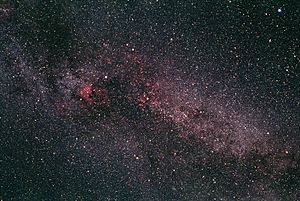
In the 1990s, people started noticing how dark the skies were at Cherry Springs. In 1999, the "Dark Sky Fund" was created to help improve the park for stargazing. In 2000, the park was officially named a "Dark Sky Park" by the state.
To make the stargazing area even bigger, the Cherry Springs Airport land was added to the park in 2006. On June 11, 2007, the International Dark-Sky Association officially named Cherry Springs State Park the second "International Dark Sky Park" in the world. This means it's one of the best places to see the stars! In 2018, the road through the park, Pennsylvania Route 44, was even named "Highway to the Stars."
Nature and Wildlife
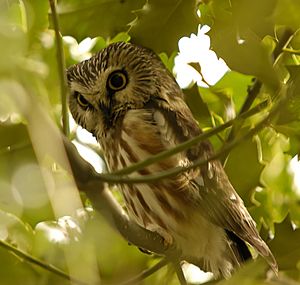
The forests around Cherry Springs State Park have grown back since the clearcutting days. Now, you'll find more sugar maple and black cherry trees. Over 400 types of birds have been seen in Pennsylvania, and many of them live or breed here. You might spot ospreys, hawks, owls, and even bald eagles. Scientists have also studied saw-whet owls in the park.
Some animals that had disappeared from the area have returned. These include white-tailed deer, elk, fishers (a type of weasel), and otters. While hunting isn't allowed in the park, it is in the surrounding state forest. Common animals you might see include black bears, deer, ducks, ruffed grouse, rabbits, gray and red squirrels, and wild turkeys. There are also chipmunks, minks, raccoons, porcupines, groundhogs, and sometimes even a bobcat.
Fun Things to Do
Stargazing in Dark Skies
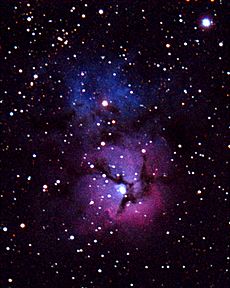
Cherry Springs State Park is a dream come true for anyone who loves stars. Its skies are super dark and clear, making it one of the best places in the eastern United States to see the night sky. The park's sky is rated as a 2 on the Bortle Dark-Sky Scale, which means there's almost no light pollution.
Imagine seeing 10,000 stars with your naked eye! That's possible here on a clear night. The Milky Way galaxy is so bright it can even cast a shadow. In big cities, you might only see a few dozen stars.
Why is it so dark here? The park is surrounded by the huge Susquehannock State Forest, far from big cities. It's also on a high plateau, so there are no mountains blocking your view. You get a full 360-degree view of the sky.
To keep the skies dark, the park has done a lot. Power lines are buried, and all lights are red and pointed downwards. Red light helps protect your night vision. Special barriers block light from cars. The park's Dark Sky Fund helps pay for these improvements.
The park has a special Astronomy Field for serious stargazers. It has domes and sheds to protect telescopes from wind. There are also concrete pads and electrical outlets for equipment. Wi-Fi internet access is available too.
Each year, the park hosts two big star parties that attract hundreds of astronomers. There are also free public programs where you can learn about the stars. You might even see Meteor showers or the Aurora Borealis (Northern Lights) from here!
Cherry Springs State Park has won awards for its dark sky efforts. It's been featured in magazines like USA Today and National Geographic Adventure.
Woodsmen's Show
Every year, on the first weekend in August, thousands of people come to Cherry Springs State Park for the Woodsmen's Show. This event celebrates the history of lumbering in Potter County. It has been held since 1952!
You can watch exciting competitions like tree-felling, cross-cutting (sawing logs), log rolling, axe-throwing, and chainsaw competitions. There are also demonstrations, music, and vendors selling food and crafts. It's a fun way to learn about the area's past.
Camping, Picnics, and Trails
Cherry Springs State Park has 30 camping sites for tents or RVs. Each site has a fire ring, lantern hanger, and picnic table. They are "rustic," meaning they don't have running water at the sites, but there are modern restrooms nearby. The camping area is open from April to December.
The main picnic area is near the large historic pavilion built by the CCC. It has many picnic tables among old apple trees and huge white pine and Norway spruce trees.
If you love trails, you're in luck! The park is at the start of a 15-mile (24 km) mountain bike trail that goes to Denton Hill State Park. In winter, it's a great place for snowmobiles. The surrounding Susquehannock State Forest has even more trails for cross-country skiing, backpacking, hiking, and horseback riding. The 85-mile (137 km) long Susquehannock Trail System also passes close to the park.
Nearby State Parks
Cherry Springs State Park is on Pennsylvania Route 44. Here are some other state parks within 30 miles (48 km) that you might want to visit:
- Bucktail State Park Natural Area
- Colton Point State Park
- Denton Hill State Park
- Hyner Run State Park
- Hyner View State Park
- Kettle Creek State Park
- Leonard Harrison State Park
- Lyman Run State Park
- Ole Bull State Park
- Patterson State Park
- Prouty Place State Park
- Sinnemahoning State Park
- Sizerville State Park
Images for kids
-
The Whirlpool Galaxy (M51) in the constellation Canes Venatici, as seen from the Astronomy Field



